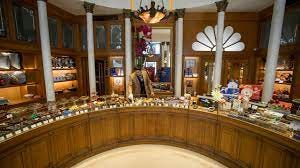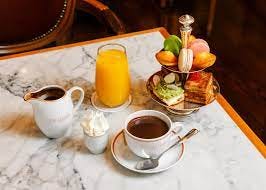THE DEBEAUVE ET GALLAIS SHOP IN PARIS
That Paris has more and better chocolate shops than any city in the world is down to an oddity of social etiquette.
Since the French rarely invite people into their homes, such a visit is a matter of some importance, and it's customary to take a small gift. Over time, the range of appropriate gifts has narrowed. To bring anything which the hosts might be expected to provide could be seen as a slur on their hospitality. Imagine guests turning up with their own cutlery, on the assumption that yours would not be good enough. Bringing an object for the home can mean that the guest may expect to see it on display on their next visit. Wine is the traditional gift in AngloSaxon countries but in Diane Johnson's novel Le Divorce, an American family's arrival with a bottle is greeted by their French host with a muttered "Didn't they think we'd give them a drink?"
The easiest option is flowers, particularly from a fashionable florist. Which florist can matter, however, and provident hostesses have been known to save the wrapping paper of a particularly chic one for later use on bouquets bought somewhere less expensive. But what else can one bring that the hosts would never create for themselves?
Well, chocolates, of course.
As the first chocolate to reach France from Mexico in the middle of the seventeenth century was reserved for royalty, it never lost its aura of luxury. Early descriptions classified it as a drug, recommended for "vapours of the spleen." In 1823, chocolatier Antoine Gallais advised that it was "prescribed by doctors with great success in cases of colds, catarrh, angina and those irritations of the throat which have become so frequent at this time because of the continual changes in the atmosphere. Chocolate also makes the organs of breathing more supple, helps those recovering from gastritis, and from all afflictions caused by inflammation."
Hot chocolate was the beverage one consumed before rising in the morning and the last thing before going to bed at night. (The chocolate placed on the pillow in the snobbier hotels is the last vestige of this practice.) The Marquise de Sévigné, a lady at the court of Louis XIV and a tireless letter writer, liked chocolat chaud so much that her young African servant brought her a pot in bed each morning and evening. She cut back after rumors of side-effects. "But what do you have to say about chocolate? " she wrote to her pregnant daughter in 1671. "Are you not afraid of how it can burn the blood? What if all the effects that appear miraculous mask some sort of diabolical combustion? What do your doctors say? I loved chocolate, as you know. But I think it did burn me; and furthermore, I have heard many terrible stories about it. The Marquise de Coëtlogon drank so much chocolate when she was pregnant last year that she gave birth to a baby who was black as the devil, and died."
Marie Antoinette can take some credit for making chocolate more accessible. In 1790, she asked the Versailles court pharmacist Sulpice Debauve to make some powdered medicine more palatable. He mixed it with cocoa, sugar and almond milk, and pressed the mixture into discs that resembled a Spanish gold coin, the pistole, each stamped with the fleur de lys emblem of the Bourbons - the original of today's boxed chocolate selections.
Luckier than his queen, Debauve survived the revolution and launched his first shop in 1800. Shrewdly he offered his expertise to Napoleon, who re-confirmed him as official chocolatier to the court. Debauve's nephew Antoine Gallais joined him in 1823, by which time Napoleon's own architects, Charles Percier and Pierre Fontaine, had designed the premises on rue des Saints-Pères. A gem of the Empire style in gilt and blue, it suited a city that saw itself as an imperial capital to rival ancient Athens or Rome.
The chocolat chaud enjoyed by Madame de Sévigné became a café staple. Marcel Proust and Coco Chanel drank theirs at Angelina on rue de Rivoli. It still uses chocolate from Niger, Ghana and Côte d’Ivoire. They add no water or milk. True hot chocolate and nothing else, it's so thick that it barely pours from the jug in which it's served.
Modern dieticians disparage chocolate, failing to take into account its power to solace and charm. "Everywhere in the world," says restaurateur Alain Ducasse (who markets his own line) "there are tensions - economic, political, religious. So we need chocolate." Marcel Proust concurred. "I recommend," he wrote to a friend, "that you regularly taste the exquisite chocolates made by Debauve and Gallais as a way of never losing sight of the true meaning of life."
HOT CHOCOLATE AT ANGELINA




